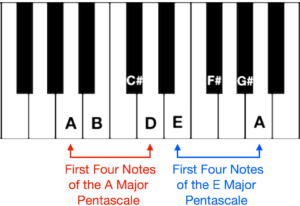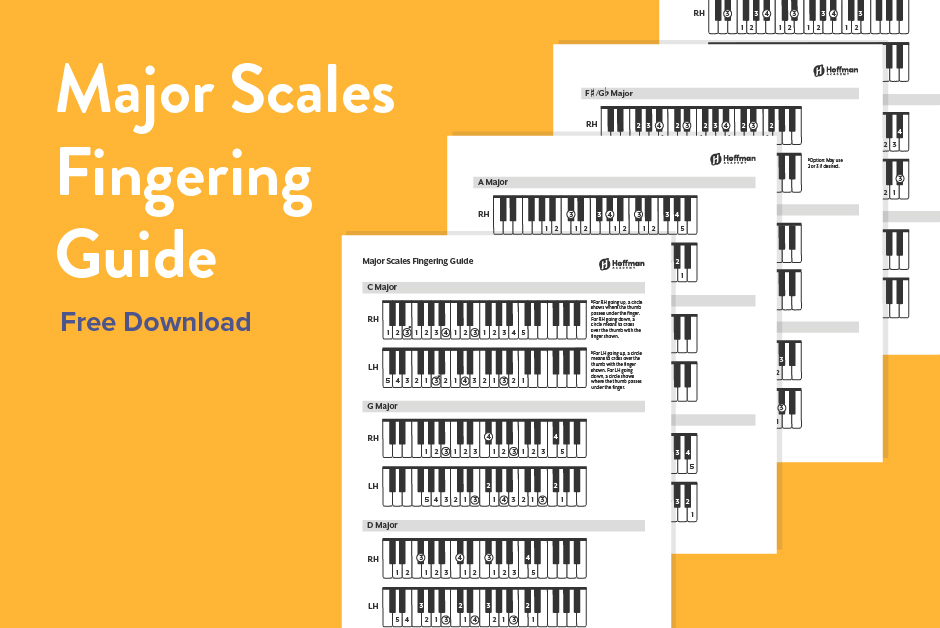Explore all major scales on piano with our comprehensive guide
We’ve put together this ultimate resource to help you succeed in playing all major scales on piano. First, watch the video with Mr. Hoffman demonstrating each 2-octave scale, posted below. Then, explore the tips and tricks for mastering major scales on the piano. Finally, we’ve included a free downloadable Major Scales Piano Guide with fingerings. Happy playing!
Video: How to Play All Major Scales on Piano
In this video, Mr. Hoffman demonstrates how to play each 2-octave major scale on the piano. To find a particular major scale, browse the video’s chapters by selecting the bullet-point icon.
How many major scales are there?
Although there are twelve chromatic pitches within the octave to build major scales on, some of them are enharmonic. This means you’ll occasionally learn a major scale whose notes can be spelled two different ways. This makes a total of fifteen. These are A, Bb, B, Cb, C, C#, Db, D, Eb, E, F, F#, Gb, G, and Ab major.
What is the formula for playing all major scales on piano?
It’s easy to build major scales, especially if you already know your pentascales. If you’re familiar with the A major pentascale, you know that you need to play A-B-C#-D-E. These are the first five notes of an A major scale, which follow this pattern of whole and half steps: W-W-H-W. To complete the octave scale, simply take the final note of the A major pentascale, which is E, and build another major pentascale on top of it: E-F#-G#-A-B. Now get rid of the final note (B) and add the first four notes of the A major pentascale to the first four notes of the E major pentascale: A-B-C#-D–E-F#-G#-A. All together, a complete major scale is built with this pattern of whole and half steps: W-W-H–W–W-W-H.

Subscribe for updates, content & free resources!
Tips & tricks for mastering major scales: piano fingering
Basic Fingering for Piano Scales: Several major and minor scales use “basic” fingering. Check out C major to see what that pattern looks like in the right hand and left hand. Put a star next to every scale that uses the same fingering – but be careful! A couple of scales, like F major and B major, use basic fingering in one hand but different fingering in the other. And several others don’t use basic fingering at all!
Are there rules to follow for playing major scales on the piano?
When playing one octave or more, it’s important to remember that your thumbs and pinkies never play the black keys! That’s why we can’t just use basic fingering for every scale on the piano, but that doesn’t mean these other scales have to be difficult! Scales that use all 5 black keys (B, F-sharp/G-flat, and C-sharp/D-flat major) have their own predictable patterns:
- Every set of 2 black keys are played by fingers 2-3 on the right hand and 3-2 on the left hand.
- Sets of 3 black keys are played by fingers 2-3-4 on the right hand and 4-3-2 on the left hand.
- Finger 1 (the thumb) is only used on white keys for these scales.
What is the difference between major and minor scales on piano?
We just learned that major scales are built from this pattern of whole and half steps: W-W-H–W–W-W-H. Minor scales follow a different pattern: W-H-W–W–H-W-W. To come up with this scale on the piano, I like to take the major scale and lower the 3rd, 6th, and 7th scale notes a half step each. With the A major scale, these three notes: C#, F#, and G# become C natural, F natural, and G natural. Now, we have just A-B-C-D-E-F-G-A. This is now the A minor scale.

Unlike major, there are actually three different types of minor scales. The scale we just learned above is called natural minor. Next there’s the harmonic minor scale. Raise the 7th note of the natural minor scale a half step, and you get harmonic minor. In A natural minor, this is G, which now becomes G#. The full A harmonic minor scale is A-B-C-D-E-F-G#-A.

Last, there’s the melodic minor scale. Once you’ve raised the 7th note of a natural minor scale to get harmonic minor, you only need to raise the 6th note as well, and you’ve got melodic minor: A-B-C-D-E-F#-G#-A. Keep in mind that, when playing a descending melodic minor scale, those raised notes return to what they were in natural minor. So an A melodic minor scale only has F# and G# when ascending; going down, it becomes the same as an A natural minor scale.

Download the Major Scales Piano Fingering Guide
Need a quick reference for the notes and fingerings of all major scales on piano? Hoffman Academy has you covered with our Major Scales Piano Fingering Guide! It’s perfect for anyone who’s learned how to play 2-octave scales and just needs an easy way to check notes and fingerings. If you’re looking for a more in-depth tutorial on playing 1- or 2-octave piano scales, we have lesson videos for those starting in Unit 9!




